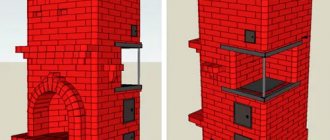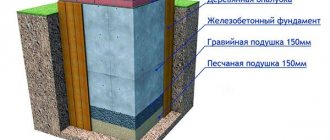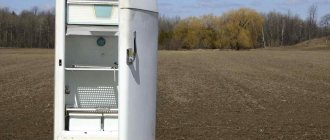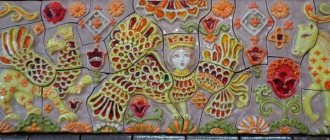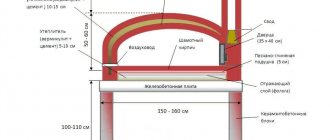Application of the Kuznetsov furnace
Over many years of inventive activity, I.V. Kuznetsov has developed about 150 models of furnaces, designed for use in all areas of human activity without exception where heat generation is required. According to the type of specialization, “blacksmithing” is:
- heating;
- cooking;
- heating and cooking;
- baths
- outdoor, intended for smoking food, barbecuing and grilling;
- fireplaces with an open firebox, allowing you to admire the flames.
Examples of the Kuznetsov furnace
We make wiring for a water heating system
The best option for a bathhouse would be a stove, into which a specially prepared water boiler is obviously installed, even at the construction stage.
In this case, the furnace acquires its own specific design features, which significantly increases the efficiency of the entire system and its compactness. Installation of such a furnace has the highest heat transfer efficiency
Heating of premises using the stove method ranks next in terms of efficiency after gas heating. The reality is that gas lines do not go everywhere, so you have to heat with wood. A conventional wood-burning stove has one serious drawback: heating efficiency is achieved only in the nearest room, and even then, not entirely evenly.
We can highlight the following nuances of using a wood-burning stove:
- Rooms located far away either remain cold or have to be additionally heated with electricity. In addition, often there is simply nothing to power powerful electric heaters. Since there is a maximum of 3.5 kW per outlet, and the power of the device exceeds 7 kW, three-phase power is required.
- In the absence of a thermal curtain, the windows constantly sweat and become covered with frost.
The solution to this problem will be to distribute the heating network from the stove throughout the premises, and install radiators for water heating under the windows. You will need to do a minimum of work: connect the stove to the water heating boiler, and make the appropriate high-quality wiring.
The simplest heating scheme will be a single-pipe one, with natural circulation of coolant. It is also called a gravitational system - in it, depending on the temperature, the liquid, increasing and decreasing in volume, circulates throughout the system.
A more detailed diagram of the furnace boiler looks like this:
- From the heat exchanger, the circuit rises upward - thus creating an accelerating manifold. An open type expansion tank is installed at its end. It is necessary to collect excess coolant due to expansion, where excess air from the heating system enters it.
- Next, the main circuit throughout the house goes back from the expansion tank to the heat exchanger, giving off all the heat to the radiators.
So that in a stove with a boiler for heating a house, circulating water can always move along the contour, there must be a slight slope along its entire length. To achieve the best circulation in it, the final part of the circuit should be as low as possible.
Scheme of water heating of a two-story wood-burning house
Combined heating system for a private house
A boiler is installed in the firebox, two pipes are connected to it - one supplies hot water, which is sent through the expansion tank into the system, the other returns water back to the register. Thus, water circulates in the system due to the force of gravitational law.
Often, small but powerful pumps are installed for good circulation. Such a pump is usually installed on a water return pipe (return); this method is especially effective when a large room is heated, which allows you to maintain the temperature in all parts of the system almost the same.
Advantages and disadvantages
The wide popularity of Kuznetsov stoves and the deep respect that people knowledgeable in the stove business have for them are due to a number of advantages:
- The efficiency of “blacksmiths” exceeds 80%, and for some models it can reach 95%.
- Furnaces operate at high temperatures, but at the same time they do without materials and technologies available only in factory conditions.
- The high-temperature mode allows you to heat the stove even with the most waste and low-quality fuel.
- Again, due to the high combustion temperature, the fuel is oxidized almost completely, so soot is formed in minimal quantities. The oven may not require cleaning for several years.
- The design of the furnace ensures very uniform heat transfer between the fireboxes, while less material is used than in construction using traditional technology.
- In furnaces equipped with a heat exchanger, heat for heating water is taken from the flue gases, and not from the firebox, so the “blacksmith” can easily perform the function of a boiler without deteriorating performance.
- The operating principle of the stove provides good draft, so there is no need to build a high chimney.
- “Kuznetsovka” is very plastic both in terms of design and design. That is, it can easily be adjusted to any room without compromising performance and efficiency.
- The stove is designed in such a way that after firing, its chimney does not need to be blocked with a view. Carbon monoxide poisoning is completely excluded.
- The design assumes uniform heat distribution in the furnace body, so cracks do not develop in the masonry due to local deformations.
What can you say about the disadvantages? Technically there are none, but there are still some things to consider. The Kuznetsov furnace cannot have massive walls - this would negate many of its advantages. But at the same time it is subject to fairly high thermal loads. Therefore, this unit must be carefully calculated and verified at the development stage and built just as carefully, with scrupulous compliance with all technology requirements. At the slightest deviation from the technical regulations, the “blacksmithing” will turn out to be very short-lived.
You can even build a Russian stove with your own hands if you follow the detailed instructions. You will find them in our next article: .
Features of operation of bell-type furnaces
The first is the automatic fuel combustion mode. In a conventional stove, when lighting, it is recommended to open the blower to its maximum width in order to create greater draft in the stove. Then, as the fire in the firebox intensifies, the door is gradually closed so that the flame temperature decreases slightly and the heat is transferred to a greater extent into the room.
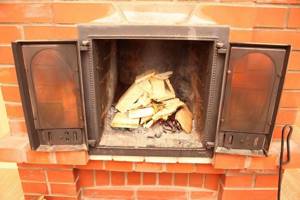
An ordinary stove requires constant attention, and “as a reward” it also dirty its owner and the space around it.
In bell-type furnaces, manipulating the doors and furnace valves does not make sense. The combustion intensity is regulated by the ratio of the volume of the hoods and the combustion chamber. This happens automatically; you just need to light the fire and add the required amount of wood or other fuel.
The second thing that pleasantly surprises is the absence of the need for daily cleaning of the ash pan. Any flammable material burns completely in the oven, without any solid residue. Almost no soot is formed on the walls of the furnace: as a result of pyrolysis, carbon is oxidized to the state of carbon monoxide (and partially carbon dioxide).
Design and principle of operation
The inventor I.V. Kuznetsov used a bell-type furnace, known for its efficiency, as a basis.
This is what a bell furnace looks like - a prototype of Kuznetsov’s model
The high efficiency of such furnaces is due to the nature of the movement of flue gases. If in channel stoves they are drawn into the chimney, often without having time to give off heat to the brick mass, then in bell-type stoves they swirl under the roof of the bell for a long time until they cool down. Only then do they fall down to the outlet, from where they then enter the chimney. The bell filled with gases simultaneously plays the role of a view: cold air from the chimney cannot penetrate into it, just as water cannot fill an inverted diving bell. This effect is called gas view.
The inventor worked with a complicated version of such a furnace, which had two hoods.
Diagram of a two-bell model
Scheme of a two-bell furnace
As you can see, the hoods are connected in series, that is, heat from the flue gases is removed in a two-stage manner. Previously, the construction of stoves with such a design was not very willingly undertaken - not only because of the complexity, but also some undesirable features. So, for example, the draft in the second bell can easily break the gas plug in the first, negating the effect of the “gas view”.
The master dealt with this drawback in the following way. The furnace was equipped with so-called downstream channels, laid to bypass the heat-accumulating parts of the array. While the flame is burning in the firebox, the convective flow it creates ensures that the draft operates as usual. When the fuel is consumed and convection stops, the draft will redistribute itself in such a way that the cold air flow will follow through the downstream channels, and not through the heated body of the furnace.
This solution not only compensated for the instability of the gas coil, but also turned out to be more reliable: a plug formed by gases can be pulled out by a strong gust of wind, while in the Kuznetsov furnace, the draft is redirected away from the hot mass under any conditions. In addition, thanks to the presence of downstream channels, there is no need to arrange room ventilation.
Order samples
This article discusses the Kuznetsov bell-type furnace, and more specifically, one of its variants. Each row should be laid out in a numbered order in full accordance with the images. This oven has a simple design and is a universal solution for household use.
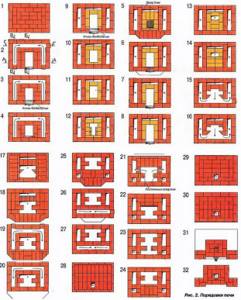
Similarly, when there is an order on the Kuznetsov stove for a bathhouse, you can do the laying yourself (read also: “Ordering a stove for a bathhouse with your own hands”). After the work on creating a heating unit is completed for the first time, it becomes clear to every performer that this is not difficult and quite doable.
Next time we will be able to make a more complex design without any problems.
It could even be a two-bell Kuznetsov stove - the order of one of the creation options of which is available as an example on the website. Perhaps in the future there will be a desire to bring into reality one of the many projects of the great master. Video of the phased construction of the Kuznetsov furnace according to the drawings:
Calculation of the Kuznetsov furnace
“Kuznetsovka” is a very complex heating device and attempts to calculate and design it yourself will not lead to anything good. You just need to choose from all the available options the most suitable one for yourself - the author does not make a secret of his developments. If the characteristics of the model you like do not indicate the heat transfer power, it can be calculated approximately: a stove that is heated twice a day, every sq. m of its surface gives off approximately 500 W of heat.
The OVIK-9 furnace, the manufacturing procedure of which we will consider, with dimensions of 1015x630x2100 mm, has a heat transfer power of 3.6 kW.
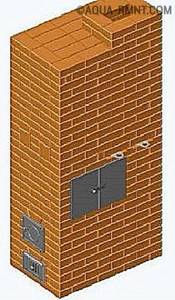
Model OVIK-9: general view
Reviews from people already using these ovens
Valentina, 40 years old: “Last year we installed a Kuznetsov stove with water heating at our dacha, and we still can’t get enough of this miracle. In addition to the fact that you can cook food, lie on a warm bed, you can also regulate the temperature in the house. Just a super oven. The only thing is that in the summer it is not possible to cook on it, since without water the heat exchanger will quickly burn out. But it’s okay, my husband bought a built-in gas panel for the kitchen and connected a propane tank to it, which has not yet been used up.”
Nikolai, 50 years old: “On the advice of friends, we decided to build such a stove in our country house. The master took a very long time to do it, and we were already starting to get nervous. But after he finished the work and we arrived at the house for the first winter weekend, we couldn’t be happier with it, and even gave the master a bonus for his work. The stove is excellent, keeps the house warm for a long time, does not smoke and does not take up as much space as we first thought. For the dacha, let’s face it, it’s perfect for the house too!”
As you can see, judging by the comments, people who have already used this type of stove are satisfied with its qualities.
The main thing is that it should be manufactured by a real professional, but to find one, you need to try hard.
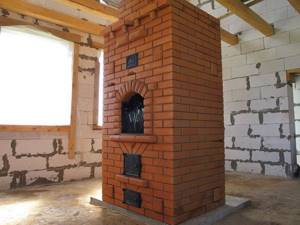
More on this topic on our website:
- Choosing an electric boiler for heating a house - price and nuances The market for heating devices is vast, however, various types of electric boilers are becoming increasingly popular. Let’s try to look at why preference is given to them in this material. Looking ahead...
- Electric boilers compare favorably with other types of heating boilers due to their compact size, ease of installation and ease of operation. When using these boilers, there is no need to stock up on fuel, arrange a complex…
- At the moment, the market for household heating equipment is following a certain trend. Every year the number of companies actively involved in the production of gas-burning equipment for the household category increases noticeably. Besides,…
- Let's look at which warm floor to choose for tiles, which one will be better in this situation to give off heat. First, let's quickly go over the theory, which, of course, is all...
Preparatory work
First of all, you need to choose a place to build a furnace. The easiest way to do this is before building a house - then both the stove and the building are designed together so that three or at least two rooms are heated. With a ready-made house, the situation is more complicated. In this case, they tend to build the stove into an interior partition, since installing it into a load-bearing wall requires complex calculations and dangerous, time-consuming work (part of the wall will have to be dismantled, keeping the load from being blocked by a system of lintels and columns).
You can, of course, limit yourself to a simple wall-mounted arrangement, but then only one room will be heated.
A reinforced concrete foundation must be built at the selected location. Its dimensions must exceed the dimensions of the oven by at least 100 mm on each side. It is not allowed to combine the foundation of the furnace with the foundation of the building - both structures give different settlements and one of the foundations will pull the other along with it, causing it to skew.
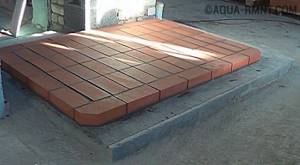
A reinforced concrete foundation must be installed under the furnace.
The depth of the foundation depends on the bearing capacity of the soil, the depth of its freezing, and the method of operation of the building (periodically/continuously). Typically, in buildings with year-round habitation of people located on stable ground, the foundation is deepened by 400–600 mm. Crushed stone should be poured onto the bottom of the excavation as a reinforcing layer, and a sand cushion should be placed on top of it.
Then everything is done using traditional technology - they install the formwork, fix the reinforcement frame and fill it with concrete. You should proceed to the construction of the furnace only after the concrete has fully matured and gained sufficient strength - this usually takes about a month.
Before laying the 1st row, waterproofing of two layers of roofing felt or roofing felt must be laid on top of the foundation. The contours of the future furnace are drawn on it with chalk - this will make it easier to navigate.
Kuznetsovka: drawings and their variety
Thanks to the basic principles used in the design, it is possible to add additional functions without increasing the overall dimensions of the oven. The main advantages and disadvantages can be described as follows:
- heating and heat transfer occurs evenly - the lower part of the furnace unit is heated in the same way as the upper part;
- The dimensions of the hob can be different - there is no rigid connection with the design;
- the injection of heat in the bell structure leads to complete combustion of hydrocarbons, so soot and smoke are practically not observed;
- very high efficiency, up to 95%;
- uniform heating protects the brick from cracking and the masonry from deformation;
- the shapes can be varied - stove makers are happy to help you select and develop a suitable design;
- many equip stoves with water circuits for local heating of their home.
The ability to design various shapes and equip these structures with heating circuits has made it possible to expand their functionality.
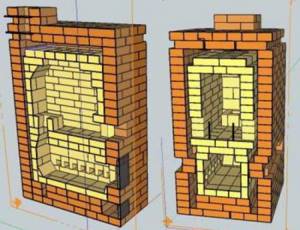
Kuznetsovka in section
- Heating options provide narrowly targeted application for effective heating of houses of various sizes and floors.
- Cooking options - use a minimum amount of firewood to quickly prepare a full lunch or dinner.
- Bath structures are characterized by high efficiency, rapid heating of washing rooms, as well as heating of water.
- Fireplace stoves, barbecues, grills and smokehouses can be reflected in stoves of this type.
- Combined options - the ability to combine multiple functions in one place.
Materials and tools
To work you will need:
- trowel;
- level;
- mallet and other construction tools.
To divide bricks you will need a pick hammer and a grinder with a diamond wheel.
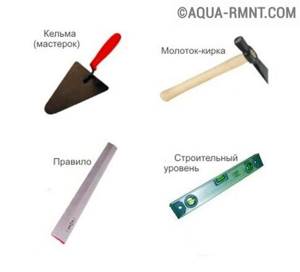
This set of tools will be needed for work
The furnace will be built from two types of bricks: conventional solid ceramic with a grade of M150 (250x120x65 mm) and fireclay grade ShB-8 (250x123x65 mm) or Sh-5 (230x114x40 mm). The firebox walls will be lined with fireclay bricks.
When purchasing fireclay bricks, you should be very careful. Unscrupulous sellers may pass it off as acid-resistant brick, which is similar in appearance but cannot withstand high temperatures. So it won’t hurt to ask to see a certificate.
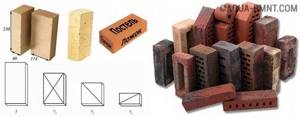
Brick for laying the furnace
It is often recommended to choose fireclay bricks by color - the darker the better. But this rule does not always apply. If clay taken from different deposits was used, then the characteristics of light brick may well be higher than that of dark brick. It is more correct to evaluate the quality of fireclay bricks according to the following criteria:
- the structure must be uniform and fine-grained - without pores and inclusions visible to the naked eye;
- when tapped with a metal object (light hammer or wrench), the brick should produce a clear, abrupt and ringing sound;
- when dropped, it should break into large pieces (low-quality ones crumble into small fragments down to sand).
For a structure with dimensions of 1015x630x2100 mm, you will need 430 ceramic bricks (excluding the chimney) and 22 fireclay bricks.
How to prepare the solution
The solution used is clay. The clay and sand used for its preparation should not contain organic impurities that can lead to cracking of the seams. In clay, the presence of these impurities can be recognized by a clearly audible smell (it can even be pleasant) - normally clay has almost no smell.
Sand should be used either from mountain sand or made by grinding broken bricks - in these varieties the content of organic impurities is minimal, or they are completely absent. Brick sand usually costs less than mountain sand, but is not inferior in quality. Just pay attention to the following circumstance: for ceramic masonry mortar you need sand from ceramic bricks, and for fireclay - accordingly, from fireclay.
Pay attention to the grade of clay. The mortar for fireclay masonry should be prepared on the basis of white kaolin or fireclay marl. Any clay with fire-resistant properties is suitable for ceramic masonry, for example, gray or blue Cambrian, gray kaolin.
Clay of the same grade, but from different deposits, can differ greatly in viscosity, fat content and adhesive properties. Therefore, the solution recipe, namely the optimal ratio of sand and clay in it, should be selected experimentally. In the case of using brick sand, this is done as follows:
- A 1 kg portion of clay should be filled to the top with water and left for a day.
- After this, the soggy clay is kneaded with the addition of water until it looks like plasticine or thick dough and stops sticking to your hands.
Next, the clay is divided into 5 equal portions, to each of which a certain amount of sand is added:
- first - 10% of the volume of clay;
- in the 2nd - 25%;
- in the 3rd - 50%;
- in the 4th - 75%;
- in the 5th - 100%.
Each portion must be thoroughly stirred until smooth and dried for 4 hours. Don't forget to mark how much sand is contained where.
After this, each portion of the solution must be rolled out into the shape of a cylinder 30 cm long and 1–1.5 cm in diameter. All of them are wrapped around a round blank with a diameter of about 5 cm. Now the test samples must be dried for two weeks at room temperature and without drafts .
After this, it remains to evaluate each of the options:
- If there are no cracks on the cylinder at all or they are present in the form of a very fine mesh, such a solution can be used for any part of the furnace.
- If the depth of the cracks reaches 1–2 mm, the solution can withstand temperatures up to 300 degrees. This mixture can be used for laying a country fireplace or barbecue.
- If there are deep cracks or breaks, the solution is considered unsuitable for use - the proportion of sand in it is excessive.
Typically, about 0.2 cubic meters are consumed for a laying of 500 bricks. m mixture of clay and sand.
Note! If you don’t mind the additional costs, you can purchase a ready-made mixture for preparing a stove solution at a specialized store.
Having thus determined the optimal combination of clay and sand, we begin to prepare the solution:
- the required amount of clay (approximately 40 kg per 100 bricks) is again soaked for 24 hours, kneaded until the consistency of dough, but then rubbed through a sieve with a mesh size of 3x3 mm;
- then sand is added according to the experimentally selected recipe;
- gradually adding water, stir the solution until creamy;
- evaluate how the solution wets the trowel and, if necessary, adjust its composition by adding a small amount of clay or sand.
What else do you need?
- A fire door, for example, brand DT-3, with opening dimensions of 250x210 mm.
- Blower door, for example, DPK brand, with an opening of 250x140 mm.
- Grate size 250x252 mm.
- Cast iron hob with two burners, size 586x336 mm.
- Doors measuring 510x340 mm, 2 pcs. – for the cooking chamber.
- Gate valves with a flow area of 130x130 mm, 2 pcs. – for the cooking chamber and for switching between summer and winter operating modes.
- A valve with a clearance of 250x130 mm - for a chimney.
- Equal angle pieces 36x4, 600 mm long (4 pcs.).
- A piece of steel strip 40x4 mm, 600 mm long.
- Steel sheet 3 mm thick, size 600x550 mm.
- 3 mm thick steel sheet measuring 500x700 mm to protect the floor in front of the firebox.
Replace steel with any other fireproof flooring, for example, ceramic tiles.
Have you always dreamed of having a magical fireplace in your home? You can fold it yourself. And the following guide will help with this: .
Materials for building a brick kiln
- Fireclay brick
for interior masonry. You can calculate its quantity according to the order. For a simple design you will need a little of it. - Clay bricks
for external masonry, when created, including Kuznetsov bell furnaces - the order will help you find out its quantity. It is advisable to purchase products of the M150 brand. - Clay
in the amount of 100-150 kilograms. It must be of good quality. Otherwise, during the first firing of the finished structure, the solution will crack. - Cleaned sand
. It will require 2 times more than clay. Ready-made clay-sand mixtures are available for sale. They are needed for 500 bricks, approximately 0.2 m³. - Metal fittings
- grate, combustion and blower doors, 2 steel angles, 5 meters of wire.
Masonry: ordering and step-by-step instructions
The sequence of work looks like this:
Lay out the 1st row of 20 bricks, which should be an ideal rectangle with a strictly horizontal surface.
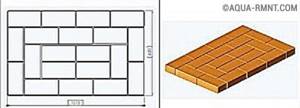
First row diagram
“Rectangularity” is checked by measuring the diagonals - they must be equal. In the absence of experience, the row must first be laid out without mortar and only then, when everything has been adjusted and checked, the mortar must be applied. The thickness of the seams should be 5 mm.
Advice. To make the stove look more attractive, install rounded bricks in the corners. You don’t have to cut them yourself—such blocks are sold ready-made.
In the 2nd row, the first (lower) hood and the blower chamber originate. The two halves of the brick are laid without mortar and slightly pushed out. When the masonry is completed, these bricks will need to be removed, which will make it possible to clean the base of the cap from splashes of mortar and brick fragments. After cleaning, the halves are finally placed on the solution.

Second row diagram
When the 2nd row is laid out (14 bricks are required), install the blower door on it, supporting it with several bricks. The door frame must be wrapped with asbestos cord, which will act simultaneously as a seal and expansion joint. It is fixed in the brickwork by means of wire, which is placed in the seams.
It is recommended to use wire to reinforce the walls of the furnace, placing it in the seams of every second row.
Having laid out the 3rd row according to the diagram (the bricks included in it should tightly fix the blower door), proceed to laying the 4th. Here, in addition to ceramic bricks, fireclay bricks are used - we begin to lay out the side and rear walls of the firebox.

Third row diagram
The blower door is covered with hewn ceramic bricks looking outwards, and hewn fireclay bricks looking inwards. They must be separated by a thermal gap of 5 mm. It can be arranged in the following way: a spacer of corrugated cardboard is placed between the bricks - it has just the required thickness; When kindled, the cardboard will burn out and a gap will form on its own. Temperature gaps must be provided wherever fireclay bricks are adjacent to ceramic bricks.

Fourth row diagram
In row No. 5, the fireclay bricks forming the side walls of the firebox are slightly shifted so that the bricks of the 4th row located underneath them form a shelf 10–15 mm wide for the grate. The bricks should be moved apart so that there is a gap of 5 mm between them and the grating, which is necessary for the free expansion of the heated metal.

Fifth row diagram
The brick forming the front wall should be cut at an angle.
In the same row, the formation of a vertical channel connecting both caps begins.
When the row is laid out, you should install the grate in its place, filling the gap between it and the bricks with sand.

Installation of grate bars
In parallel with laying the 6th row, you need to install and fix the fire door. Direct contact of its frame with the brick is not allowed - it is necessary to lay an asbestos cord as a gasket. The door frame can be fixed with wire from below, but a more reliable element is required from above - the wire will quickly burn out. Instead, a steel strip is used.

Sixth row: installation of the combustion door
When laying row No. 7 on the side of the brick that forms the back wall of the firebox, a gap of 20–30 mm wide is left. This is the beginning of a dry weld.

Seventh row diagram
Having laid out row No. 8 according to the diagram, proceed to laying the 9th row. At this stage, a channel is formed connecting the firebox with the lower hood. Lilac color indicates bricks in the side walls of the firebox, the upper edges of which should be 10 mm below the plane of the row. An asbestos strip 10 mm thick will need to be laid on the left wall so that it is flush with the plane of the row.

Eighth row diagram
Pay attention to how the fire door is blocked: the bricks are cut at an angle to create a “lock-on” masonry.

Ninth row diagram
When laying out the 10th row, you should remember that ceramic bricks must be laid without mortar on the asbestos lining (it covers the fireclay bricks in the firebox wall).

Tenth row of order
It is necessary to make a cutout for the hob in the ceramic bricks surrounding the firebox. Its dimensions should be such that there is a temperature gap of 5 mm around the slab, that is, the bricks will need to be trimmed by about 10 mm. And in the contact area of the hob with fireclay bricks, it is necessary to leave a gap of 10 mm. These bricks, cut at an angle, are located in the front and to the right (indicated in orange).
If the slab is equipped with stiffening ribs at the bottom, it is necessary to additionally cut grooves in the brick so that the slab is supported on the brick along the entire edge. It is installed immediately after laying the row - on an asbestos cord soaked in clay solution. The gaps between the slab and bricks are filled with sand.
Near No. 11 the walls of the cooking chamber begin. A door for it is also installed here, the frame of which must be wrapped with asbestos cord. For fixation, you can again use wire.

Eleventh row diagram
Rows 12, 13 and 14 do not need comments - we simply lay them out in order.
After laying the bricks of the 15th row, the cooking chamber is covered with a steel sheet 3 mm thick and 600x550 mm in size with a cutout for the exhaust duct. The top of the sheet is reinforced with 4 pieces of angle and a steel strip. The steel ceiling prevents various small debris from getting into the food, which could fall into it from the brickwork.

Installing the hob
In the bricks of the 16th row, framing the exhaust and front vertical ducts, cutouts are made for valves, taking into account a 5 mm temperature gap.

Scheme of the 16th row
When the row is laid out, the valves are installed in place.

Installation of valves
After the 17th row, the formation of the upper cap begins (18th row). Here, too, it is necessary to leave the slightly extended halves without mortar; by removing them, it will be possible to clean the base of the cap from the mortar and various debris that fell during the laying process. After cleaning, the removed bricks are coated with mortar and finally installed in their place.

The eighteenth row of the order is the beginning of the formation of the cap
Rows 19 to 27 are laid out in order.
In the 28th row the main chimney damper is installed. Under it, cutouts should be made in the bricks with a depth of 10 mm (indicated in lilac) and such a width that a temperature gap of 5 mm remains around the valve body.

Scheme of the 28th row
The valve must be installed immediately after laying out the row, and it is laid on the solution.

Installation of a chimney damper
In rows No. 29 and 30 the furnace is closed, and in row No. 31 a mounted pipe begins with a smoke exhaust channel into the brick (270x140 mm).

Formation of the casing pipe
The finished oven must be thoroughly dried. To do this, it is kept for some time with the doors and valves fully open. Things will go faster if you hang a light bulb with a power of 200–400 W in the firebox. It will provide not only heat, but also a stable convective flow, which will remove all moisture in a short time.
The first fire should be done with a small portion of fuel - the fire must first harden the walls of the firebox.
You should not start finishing the stove before it has fully worked for the first season - the decorative coating may be damaged during shrinkage processes.
Building a stove with your own hands: from preparation to inspection
Before starting construction of the structure, you should carefully study the plan of the room in which it will be located. Since this is a heavy attribute, a solid foundation is required. If the stove is being built in a wooden structure, then it is necessary to install gaskets made of fire-resistant material at the joints of the stove structure and walls.
Stove foundation
To build it, you need to dig a rectangular hole. Its dimensions: length 1.5 meters, width 1 meter, depth 1 meter. The bottom is covered with a layer of sand to a depth of 15 cm. This should be left for several days for shrinkage. Then formwork is placed from boards or other wooden elements.
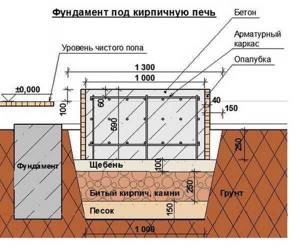
The next stage: laying out a thin metal rod to reinforce the concrete. Then the concrete is poured. During the process, it is necessary to periodically remove any air bubbles that form from it. An ordinary shovel or a concrete vibrator will help with this. According to the level of location, the concrete for 2 bricks should not reach the floor surface.
After the surface of the slab is perfectly leveled, the concrete should be left for several weeks to harden. The longer this period is, the stronger the foundation of the furnace will be.
Furnace laying
Laying bricks in Kuznetsov’s models can be done independently even by beginners. The main thing is attentiveness. It is necessary to strictly follow the scheme - the order.

Since brick tends to expand when heated, the internal fire-resistant shell must have free space on all sides. For this purpose, every third row of brick is laid with metal wire to strengthen the bond. As for the oven doors and its other metal components, the degree of their expansion during heating is taken into account during installation. Brick and metal are separated by a special gasket.
On rows 17–18, the top overlap of the caps follows. On the 21st tier, two passages should be left along the side internal walls. The instructions describe the order in detail, and usually there are no difficulties with masonry. After completing the masonry, it is advisable to apply a fireproof compound to the walls.
Functionality check
To test the stove during the first lighting, use a minimum amount of fuel. This is done so that warming occurs gradually. At the time of the first fire, the operability of the structure, the firing of the furnace, and the tightness of the seams in the places where doors and valves are installed are checked. If problems are identified, they must be corrected.
Operation in various modes
In summer mode, Kuznetsov’s stove turns from a heating and cooking stove into a cooking stove. To do this, it is enough to open a special valve (it is called the summer valve), after which the flue gases will enter the chimney directly, bypassing the caps. Accordingly, only the hob will be subject to heating.
The temperature inside the cooking chamber can be regulated by a valve installed on the exhaust duct extending from it. By closing the valve and the chamber door, it can easily be turned into an oven. For ease of use, shelves for baking sheets can be fixed in the walls.
If you need to quickly warm up the room or dry out, open the door of the cooking chamber. At the same time, the temperature on the burners remains high enough for cooking.
Industrially manufactured stove
In order to better understand the structure of the stove, as well as its functional capabilities, it is enough to consider all this using the example of products manufactured in production. Its components are as follows:
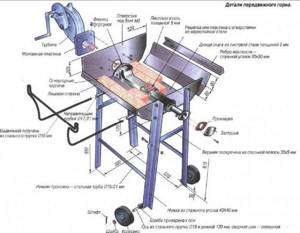
Scheme of an industrial forge.
- lance, otherwise a nozzle, through which air is supplied into the chamber;
- refractory brick helps maintain the required temperature in the furnace;
- the hearth board or grate bars perform the function of retaining fuel above the air chamber;
- furnace socket for loading solid fuel;
- bricks with which the frame of the forge will be formed;
- a fan that will supply air to the oven;
- a metal frame that will hold the structure;
- air chamber;
- ashpit (ashpit);
- air duct and casing.
What is the difference
The main feature of the group of stoves invented by Kuznetsov is the absence of extended smoke channels with many turns and bends. To make the most of the heat from burning fuel, duct stoves have a system of passages through which hot smoke heats the bricks. In this case, the oven heats up unevenly at different levels, which can lead to cracking of the masonry. In addition, there is a need for regular cleaning of narrow places and corners.
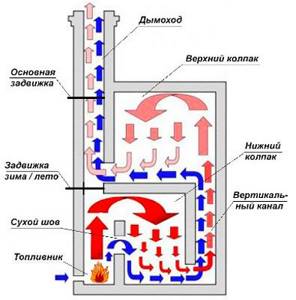
Kuznetsov's stoves for home and bathhouses do not have this drawback. In them, hot gases from the firebox enter the so-called hood - an internal space limited at the top by the ceiling and having an outlet at the bottom. The heated smoke rises to the very top of the hood, where it lingers until it begins to cool. As they cool, they gradually fall down along the walls of the bell, and a new portion of smoke takes their place.
The cooled smoke exits through the channel into the chimney or into another hood, depending on the design and purpose of the stove. Gradually, as it passes through cascades of hoods, the flue gases cool to a temperature of 120-150 degrees. The temperature of the gases at one level of each cap is the same, which avoids uneven expansion of the brick.
Water heating device
The water circuits, heated by the fuel, heat the installation, the smoke channels and the walls of the heating unit heat up. Batteries are connected to the heater, which become warm during the combustion of fuel in the firebox. The heated unit provides heat to the room until the walls have completely cooled down.
Elements:
- bake;
- a heat exchanger located inside, around the device in the form of a coil;
- water circuits located around the perimeter of the room.
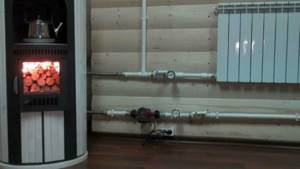
Device structure
A heating installation that heats water circuits is more affordable when compared with other air heating equipment.
Water circulation diagram in the circuit
The heating system is built according to the scheme of natural coolant circulation through water circuits. The device is installed in the center of the room, supply pipes connected to the main heating center are placed in a circle.
The device will effectively heat the room and provide a comfortable temperature. It is not profitable to equip houses consisting of several tiers with a long-burning device. You will have to install a large stove, attaching many radiators, this is expensive and ineffective.
A standard installation with connected radiators consists of:
- heat exchanger;
- metal circuit pipeline;
- radiators, thick pipes;
- expansion tank.
With a one-time supply of fuel, the equipment will heat the house for twelve hours.
Oven – brick or metal
What material is best to build a long-term heating device from? Most often they choose a brick or metal structure.
Brick takes longer to heat up, but the heat transfer is longer. Long-burning steel equipment, on the contrary, heats up quickly and cools down in a short period of time.
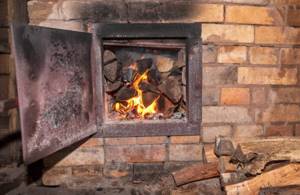
Brick firebox
The brick installation is heavy, it must be capital, with a foundation and additional fastenings. It is better to install during the construction of the house.
If you plan to live in the house permanently, a brick oven is suitable. The heating device is expensive and difficult to install, however, it has a high efficiency.
A budget metal stove with connected water radiators. The structures are short-lived, but are suitable for irregular heating of the air in the house.
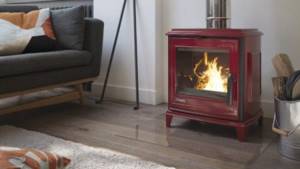
Metal unit
The choice depends on the wishes of the owner of the living space; if you want to build a heating system for a long time, it is better to choose a brick structure.
Pipes – stainless steel or metal-plastic
If structures with water circuits are used, you can choose steel, metal-plastic or polypropylene pipes.
Metal-plastic pipes are popular. However, if you are not sure that the temperature of the heated water will not exceed 95 degrees Celsius, it is better to install heat-resistant stainless steel pipes.
Heat dissipation - radiators or register
The slow flow of heat into the circuits ensures long-term heating of the room; you need to connect the correct heat exchangers for the installed main device.
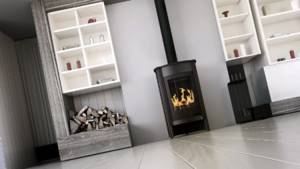
Heat exchanger selection
The radiator looks like a battery, the register is a pipe connection. The radiator fits into the interior. The register is suitable for heating a private country house. They are more often found in villages and villages, where the issue of aesthetics is not important, the main thing is financial benefit and simplicity of design.
If the equipment is installed correctly, according to a pre-designed scheme, both heat exchangers will provide heat to the house.
Selecting a heat exchanger for the furnace
Most often they are made of steel, cast iron, copper. The copper heat exchanger is of high quality, but the price is too high. And it’s difficult to solder the device yourself.
Cast iron has better characteristics than steel. Making a heat exchanger with your own hands is difficult. If you take a finished battery, when the fuel burns in the firebox, the seal located between the sections will gradually burn out. This increases the risk of water leakage into the firebox and will significantly reduce the efficiency of the stove. It is difficult to clean soot from the inside of a cast iron battery.
A steel coil or a sheet metal jacket is the most advantageous option. The structure is easy to assemble by connecting several elements.
Techniques for safe operation of a water boiler
The proper operation of the heating installation and long service life directly depend on the handling of the stove from the first days after its creation.
Do not attempt to heat the house if the water has been drained from the heat exchanger. The resulting damage cannot be repaired.
Also, you cannot pour liquid into the pipes if the furnace is already heating up, and the owner later remembered this, since the circuit will begin to crack from the temperature difference.
It is possible to pump moisture without using a circulation pump, but then the speed of water movement will be significantly reduced. This will result in reduced heat transfer from the heating system.
If a break in heating work is planned during cold times, it is possible to prevent freezing of pipes by pouring specialized antifreeze inside the pipes.
It is not allowed to cut off the water flow while the stove is burning, since without complete cooling there is a risk of rupture of the overheated heat exchanger.
The heating stove designed by Kuznetsov has great potential benefits for everyday life, especially in cold climates. But the complexity of execution, the presence of multiple nuances of masonry, will require mandatory consultation with an experienced stove master.
The step-by-step process of assembling the Kuznetsov stove is shown in the following video:
Average score of ratings is more than 0
Share link
Comments There are no comments yet, but you could be the first...
Heating boiler assembly
In order not to look for any special materials to assemble a water tank, you should consider cast iron heating radiators as an alternative. They are the most reliable, as they can easily withstand high temperatures inside the oven. The unit must be disassembled into its component parts and washed with a solution of hydrochloric acid to remove scale and residual products of former water heating.
Then the sections are connected using asbestos cord, previously soaked in drying oil, as a seal. It is wound onto the joints and carefully knocked down the structure along with the cast iron nipples. Leave the holes free, on one side - the top and bottom. The supply and return pipes will be laid there. Thus, the heat exchanger for the furnace is ready.
